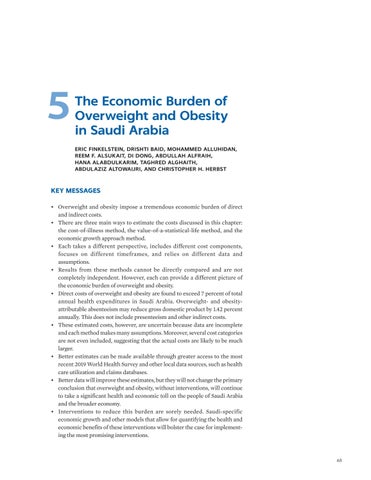5
The Economic Burden of Overweight and Obesity in Saudi Arabia ERIC FINKELSTEIN, DRISHTI BAID, MOHAMMED ALLUHIDAN, REEM F. ALSUKAIT, DI DONG, ABDULLAH ALFRAIH, HANA AL ABDULKARIM, TAGHRED ALGHAITH, ABDUL AZIZ ALTOWAIJRI, AND CHRISTOPHER H. HERBST
KEY MESSAGES • Overweight and obesity impose a tremendous economic burden of direct and indirect costs. • There are three main ways to estimate the costs discussed in this chapter: the cost-of-illness method, the value-of-a-statistical-life method, and the economic growth approach method. • Each takes a different perspective, includes different cost components, focuses on different timeframes, and relies on different data and assumptions. • Results from these methods cannot be directly compared and are not completely independent. However, each can provide a different picture of the economic burden of overweight and obesity. • Direct costs of overweight and obesity are found to exceed 7 percent of total annual health expenditures in Saudi Arabia. Overweight- and obesity- attributable absenteeism may reduce gross domestic product by 1.42 percent annually. This does not include presenteeism and other indirect costs. • These estimated costs, however, are uncertain because data are incomplete and each method makes many assumptions. Moreover, several cost categories are not even included, suggesting that the actual costs are likely to be much larger. • Better estimates can be made available through greater access to the most recent 2019 World Health Survey and other local data sources, such as health care utilization and claims databases. • Better data will improve these estimates, but they will not change the primary conclusion that overweight and obesity, without interventions, will continue to take a significant health and economic toll on the people of Saudi Arabia and the broader economy. • Interventions to reduce this burden are sorely needed. Saudi-specific economic growth and other models that allow for quantifying the health and economic benefits of these interventions will bolster the case for implementing the most promising interventions.
65






